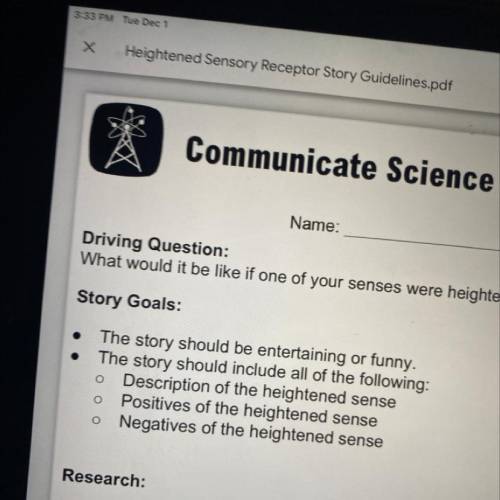
Biology, 02.12.2020 03:00 beausisugpula
Use the attached "Story Guidelines" Handout to write an imaginative story about a
person with a heightened sense! Your story should be at least three well-developed
paragraphs long. Have fun with it and be creative...be humorous!
IMPORTANT: Use the copy of the STEMScopedia for this unit to incorporate all of the
terms related to your character's heightened sense. For example, choose a specific
type of receptor (chemoreceptor, thermoreceptor, mechanoreceptor, photoreceptor,
nocicepter or propiorecepter), and then include the terms and parts of the body
related to those receptors. Weave it into an episode in the life of your character.


Answers: 2


Other questions on the subject: Biology

Biology, 22.06.2019 02:30, kaliloabousjbf
In the diagram below, the northern hemisphere would be in what season at position a a. fall b. winter c. summer d. spring
Answers: 1

Biology, 22.06.2019 03:00, sophiav9780
Where does all the water go? according to the environmental protection agency (epa), in a typical wetland environment, 39% of the water is outflow; 46% is seepage; 7% evaporates; and 8% remains as water volume in the ecosystem (reference: united states environmental protection agency case studies report 832-r-93-005). chloride compounds as residuals from residential areas are a problem for wetlands. suppose that in a particular wetland environment the following concentrations (mg/l) of chloride compounds were found: outflow, 60.4; seepage, 73.7; remaining due to evaporation, 26.4; in the water volume, 46.8. (a) compute the weighted average of chlorine compound concentration (mg/l) for this ecological system. (round your answer to one decimal place.) mg/l (b) suppose the epa has established an average chlorine compound concentration target of no more than 58 mg/l. does this wetlands system meet the target standard for chlorine compound concentration? yes. the average chlorine compound concentration (mg/l) is too high. yes. the average chlorine compound concentration (mg/l) is lower than the target. no. the average chlorine compound concentration (mg/l) is lower than the target. no. the average chlorine compound concentration (mg/l) is too high.
Answers: 3

Biology, 22.06.2019 03:30, youngaidan21
The graph below compares the rates of reaction of a burning candle and an exploding firework. comparing chemical reactions what can you conclude from the graph? the reaction that causes a firework to explode requires less energy to start, and occurs more rapidly than the reaction that causes a candle to burn. the reaction that causes a firework to explode requires less energy to start, and occurs less rapidly than the reaction that causes a candle to burn. the reaction that causes a firework to explode requires more energy to start, and occurs less rapidly than the reaction that causes a candle to burn. the reaction that causes a firework to explode requires more energy to start, and occurs more rapidly than the reaction that causes a candle to burn. mark this and return
Answers: 2
You know the right answer?
Use the attached "Story Guidelines" Handout to write an imaginative story about a
person with a hei...
Questions in other subjects:

Social Studies, 08.01.2021 21:50

Mathematics, 08.01.2021 21:50


History, 08.01.2021 21:50









